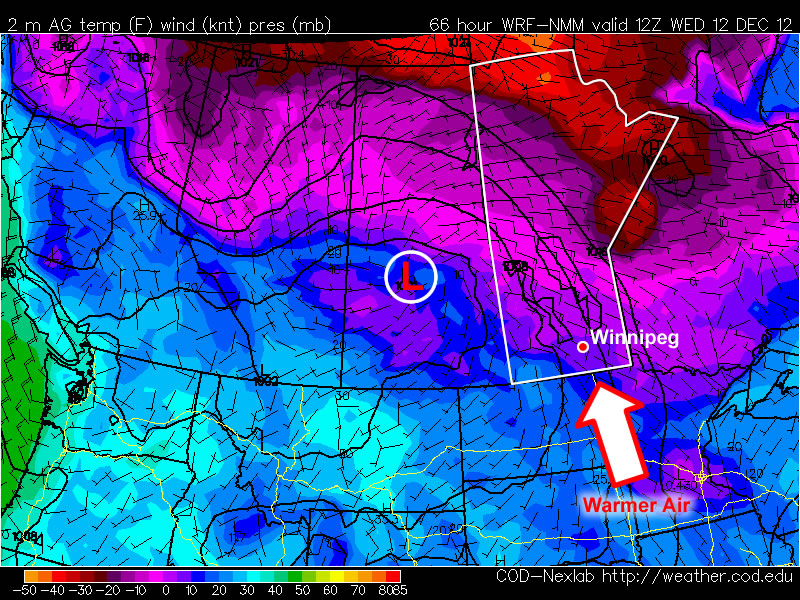Winnipeg seems to have found itself in the firm grip of winter as below-seasonal temperatures dominate the forecast. A low pressure system passing to our south today will bring snow and a slight moderation to our temperatures to near-normal values, but we’ll quickly drop back to well below-normal temperatures.

Liquid-equivalent (how much water there would be if you melted the snow) precipitation accumulation valid 18Z today.
A weak upper trough will swing through Southern Manitoba today, embedded within a strong northwesterly flow. While temperatures have warmed some 10-15°C aloft over the entirety of the Red River Valley, it looks like the surface warm front will halt part-way between Winnipeg and the U.S. border. Areas south of the warm front (probably areas south of Morris) will be able to tap into a southerly or even southwesterly flow, allowing temperatures to warm possibly as high as -5°C. Unfortunately for areas over the Northern Red River Valley, the warm front will likely remain well to our south, keeping our winds out of the southeast and slowly backing to northwesterly as the system passes by. These wind directions all favour the reinforcement of cold air as they tap into the colder air ahead and north of the low instead of the warmer air south of the low. That means that while there will be a slight increase in temperature from the advection (bringing in) of warm air aloft, a significant portion of the warming taking place over the Northern Red River Valley will be due to heat directed towards the surface from the clouds associated with this low. Highs north of the warm front will sit in the -12 to -15°C range.
Snow associated with this system pushed in overnight and will continue through the morning before tapering off around lunch time. Heaviest accumulations will lay north of the warm front with lighter accumulations south of the warm front. North of the warm front, including here in Winnipeg, we’ll see a total of 6-8cm of light, fluffy snow, while south of the warm front (the Southern Red River Valley) will probably only see a total of 2-4cm. There’s a slight chance that a few lingering flurries will hang on through the afternoon, but accumulations with those would be minimal should they happen.
Temperatures will drop down to around -25°C tonight as the clouds begin to break up and cold air filters southwards again in a northerly flow behind the low. Temperatures struggle to climb above -20°C tomorrow as we find ourselves deep in the cold air once again, some 8-10°C below normal for this time of year.
There are hints that temperatures may begin to moderate on Friday into the weekend, climbing as high as -9°C on Saturday, as a weak south/southwesterly flow develops. I’ll bite my tongue for now as models can sometimes be overly enthusiastic on moving the cold air out of the Red River Valley, but it does look like it’s at least a possibility. If that flow does develop, it’s likely we’ll see another batch of snow late this week as the warmer air pushes in. Until then, keep the long johns handy and be sure to check back in the comments below or follow along on Twitter for updates as the week progresses!




